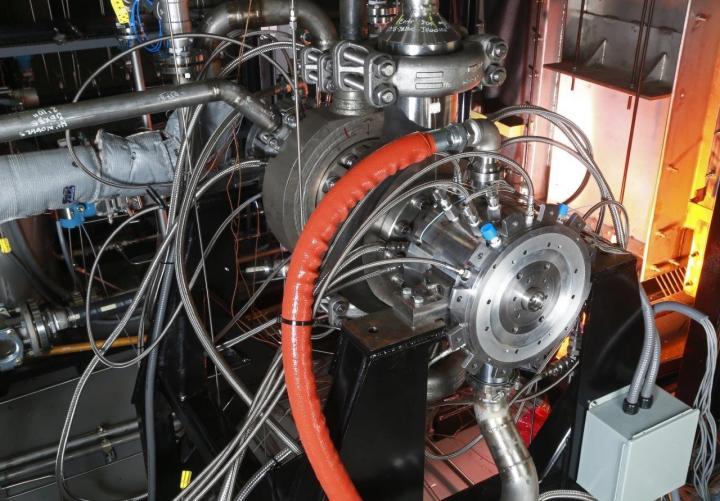Powerful, desk-sized 10 MWe industrial turbine operates at 1,300 degrees Fahrenheit to improve electricity production

Credit: Southwest Research Institute
SAN ANTONIO — April 8, 2019 — A team of Southwest Research Institute and General Electric (GE) engineers have designed, built and tested the highest temperature supercritical carbon dioxide (sCO2) turbine in the world. The turbine was developed with $6.8 million of funding from the U.S. Department of Energy (DOE) Solar Energy Technologies Office (SETO), in addition to $3 million from commercial partners GE Research, Thar Energy, Electric Power Research Institute, Aramco Services Company and Navy Nuclear Laboratory. Additionally, the DOE’s Advanced Research Projects Agency – Energy (ARPA-E) Full-Spectrum Optimized Conversion and Utilization of Sunlight (FOCUS) program provided financial support and extended the test program to validate advanced thermal seals.
“The full 10-megawatt turbine is the size of a desk and yields the highest power density of any industrial turbine, rivaled only by the turbopumps used on the space shuttle engines,” said Dr. Jeffrey Moore, a mechanical engineer at SwRI and the principal investigator of the project. “This will not only improve concentrated solar power plant efficiency but also improve the efficiency of fossil and nuclear power plants, as well as lower the cost of waste heat recovery and energy storage.” This small but powerful turbine can withstand the tough operating conditions of concentrated solar power (CSP) plants and is highly scalable, to as much as 450 MW. This technology could result in a two to four percent efficiency increase for fossil plants, reducing CO2 emissions equivalent to 14 million cars.
CSP plants use mirrors to concentrate solar energy to drive turbines, which generate electricity using a working fluid, typically steam, at high pressures and temperatures. Achieving the conditions needed for sCO2-based systems required the SwRI team to overcome a number of significant engineering challenges.
Over the past five years, the SwRI team worked with SETO and their collaborators to create a multi-stage axial flow sCO2 hot gas turbo-expander. Collaborator GE Research contributed significantly to the turbine’s design, especially in the creation of the turbine’s rotor.
The axial turbine expands high-pressure sCO2 gas to produce enough power to drive the compressor and generator that create electricity in CSP plants. These turbo-expanders must operate at temperatures greater than 1,300°F and pressures over 3,600 psi under a wide range of load conditions. They must also maintain high efficiency, a fast start-up time and the ability to handle rapid swings in transient heat input. Tested in custom-built high-pressure sCO2 test loop, the turbine met all mechanical and performance objectives, including full temperature, pressure and speed.
“Most conventional CSP systems operate at a thermal efficiency of 35 to 40 percent. The newly designed turbine with the sCO2 power cycle can approach a 50 percent efficiency,” Moore said. “In addition to more efficient and cost-effective power, the new turbine will also allow CSP plants to be more economically competitive with fossil fuel power plants.”
A variation of the turbine will be incorporated into the Supercritical Transformational Electric Power (STEP) 10-megawatt demonstration plant, a $119 million sCO2 pilot plant currently under construction at SwRI’s headquarters in San Antonio. Developed through a collaborative partnership between Gas Technology Institute (GTI), SwRI and GE and funded by DOE’s National Energy Technology Laboratory, STEP will demonstrate a fully integrated sCO2 power plant that generates power at higher efficiency and lower costs with a smaller carbon footprint than conventional plants.
“We’re hoping to prove that we can operate at scale with good safety and control systems,” said Engineer Douglas Hofer, who guided the turbine development at GE Research headquarters in Niskayuna, New York.
###
For more information, visit https:/
Media Contact
Robert Crowe
[email protected]
Original Source
https:/



